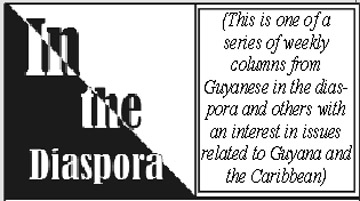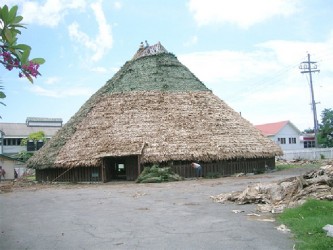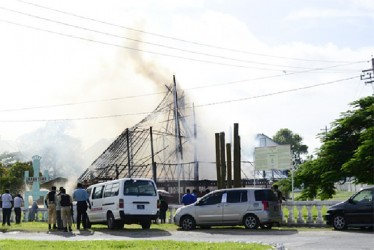By Maya Trotz
Maya Trotz teaches environmental engineering at the University of South Florida, Tampa

Under the leadership of Wai Wai Chief Elka, this construction was completed in 80 days in time for a meeting of the Foreign Ministers of the Non-Aligned nations. According to the Ministry’s website, without an adequate space to host to the meeting, the planning committee chose an Amerindian benab given limited funds and time for construction. Formed after the Asia-Africa Conference held in Bandung, Indonesia in 1955, the Non-Aligned Movement (NAM) established criteria for membership to countries that maintained their independence and resisted pressure from the major powers. With 120 member countries and 17 observer countries, including China, NAM’s focus has changed from its early preoccupations with the cold war and colonialism, to addressing socio-economic challenges facing member states’ and resistance of western hegemony. Founding member countries like Yugoslavia don’t exist anymore as one entity, breaking up more than two decades before the Umana Yana fire on September 9th of this year.
Social media posts by Guyanese demonstrated a general sentiment of sadness as pictures of the fire emerged. As forestry expert Racquel Thomas-Caesar noted, the “Umana Yana belonged to all of us. I went to so many activities there, recently a jazz concert. A friend got married there years ago. I have attended fashion shows, horticultural shows, lectures, exhibitions and Amerindian heritage events there.” Social media posts also registered a sense of distrust that the fire was set on purpose to provide space for private interests. And sadly, this is the Guyana of today.
The fire at the Umana Yana brings up many topics that can be used to discuss and understand this topic of sustainability. This “meeting place of people” was erected in time to host a meeting of foreigners, brought an indigenous group from deep within Guyana to the coast to erect a structure used by them, and then 2 years later was the chosen site for the installation of an African Liberation monument in the front of the compound. If one went back in time, how would this space be discussed through a sustainability lens? Global to local connections?
I have had the privilege of visiting Masekanari, the current village in the Konashen district where the Wai Wai live in southern Guyana, and where their benab sits in front of a forest so vast. One of the few remaining tropical forests still standing in the world, these are places struggling to resist pressures from all forms of mining and destruction. The benab in town that was gifted by the Wai Wai over forty years ago sat in the midst of tall wooden and concrete structures, just minutes away from where Georgetown’s raw sewage gets discharged into the Demerara river, and a stone’s throw away from the controversial Marriott hotel under construction. For Guyanese living on the coast, most of whom have never had the opportunity to travel into the interior parts of their country, this was one of the only spaces that represented the construction methods of the Wai Wai. I limit it to construction methods here (and Wai Wai as I also do not know whether it represents the construction methods of the eight other indigenous groups, like the Arawak, Akawaio, Arecuna, Macusi, Warrau, Wapisiana, Patamona and Carib), as perhaps we need to ask ourselves if we have ever really drawn on this incredible opportunity to reckon with the indigenous philosophies, the ways of being that were woven into the thatched roof of the Umana Yana. Did we fully understand what it meant to have “meeting places of people” that are truly places for people, from all walks of life, to meet and do more than meet, to build consensus, learn from each other, imagine, create and be creative? What would those look like? What lessons have we learned from the Umana Yana that can be used to create a Guyanese appropriate space to do all of these things? Or a series of spaces all over the country?

When I first heard of the fire I immediately thought of anecdotal stories I had been told of the difficult living conditions that many of the Amerindians who helped with repairing the roof sometime prior to 2006 endured while in Georgetown. What an irony! Then I saw pictures of the fire at the Umana Yana. And loads of engineering questions ran through my mind. It was just a few days ago that I was discussing this building in the context of Caribbean spaces for creativity with a friend. In Trinidad and Tobago, a National Academy of Performing Arts (NAPA) stands as a beacon of Caribbean performance space. Copied directly from Sydney, built by Chinese workers with a ceiling that has caused its recent closure due to dropping parts, and air conditioned to the max. One would hope that up and coming students look critically at the world around them and not only imagine the world they want, but also figure out what works and is relevant in a given context, and how to make it happen.
I currently teach a course on sustainability development engineering this semester and we have partnered with a local Florida community made up of diverse partners, some of whom are English language learners. My students will develop and apply sustainability matrices to the various projects they work on for the community’s farm. For each of the five pillars of sustainability a series of questions will be used to score the various phases of their project: needs assessment, conceptual design and feasibility study, design and action planning, implementation, operation and maintenance. While their projects may not reach the implementation phase, a major lesson taken away from the course will hopefully be the importance of community engagement/stakeholder participation and knowledge sharing. The last time I was in the Umana Yana it was for the 2013 national competition of the Sagicor Visionaries Challenge, a sustainability challenge that has since expanded to schools in Tampa Bay, Florida. Teams of secondary students from across Guyana shared their project ideas with the public on how to improve their schools and/or communities. It was an emotional and overwhelming moment to see students arriving in minibuses early on a Saturday morning with peers, family, and exhibits to participate in a competition that asked them to address sustainability, science, technology, engineering and mathematics. The use of that space by Sagicor and the Ministry of Education seems even more significant now that I am reflecting on sustainability and the Umana Yana as that day was truly a meeting place filled with Guyanese of all ages, from all parts of the country, with all sorts of creative ideas and discussion. And just a few weeks ago, the Janus Cultural Policy Initiative hosted their important Conversations on Citizenship in this meeting place that for now is no more, bringing Guyanese together to talk about their hopes for themselves, each other and the country, and to begin to address difficult issues like race.

The tragic fire consumed the coastal meeting space in less than twenty minutes – might we read this as symbolic of how precariously perched our beloved country is right now, teetering on a brink and in desperate need of our collective attention and healing care? One person commented on facebook, “So tragic, the moreso during Amerindian Heritage celebrations. A part of me is whispering that perhaps this was an act of self-immolation: the building’s spirit (and it surely had one) making the ultimate sacrifice to protest the destruction of Guyana’s forests.” Like the Non Aligned Movement that has reinvented itself to address the contemporary global landscape, one might want to revisit the Umana Yana. In contemporary Guyana, how do we radically envision a meeting space? How do we transform those meetings into action so students are not stifled at the project conceptualization and design phase? How do we transform those meetings so concert/exhibit/performance attendees are not limited to one night of events? Imagine the possibilities if Guyanese students were asked to build a 460 square meter “meeting place of people” that encouraged action oriented outcomes, had a roof 16 m high, could last 40 years, that used no nails, that used locally sourced materials with minimum chemical additives, that would pose low risk to anyone inside in the event of a fire given limited firefighting equipment, and that could be rebuilt within two and half months if needed. Who would you partner with, how would you do it, how would it look? The Wai Wai provided us with a template four decades ago; as promises are made to rebuild and to draw on indigenous knowledges once again, are we ready and prepared to listen to all of the teachings they offer, that go far beyond a single building to promise a different way of living for us all?





